Tracy Wood of Visually Delicious writes about her recent trip to the home of her favourite cheddar cheese.
Recently I had the pleasure of visiting Quicke’s in Devon: the makers of my favourite cheddar cheese. And, even better, I was invited for a private tour of the Home Farm. For me it was like being a kid in the world’s best lolly shop. Inspired by their cheese I’ve included a recipe I developed after returning home, but more of that later.
 Quicke’s have owned the land for fourteen generations – since the time of Henry V111, courtesy of his divorce with Anne Boleyn as a part of her settlement. An interesting story but one I won’t go into here. Today the Home Farm consists of 3,000 acres straddling both sides of the road running into the picturesque village of Newton St Cyres. About a third is farmland, the other 2,000 acres woodland, predominantly oak trees, also used in the making of their smoked cheddar. The original family home still looks down over the village from a small hill – quite an impressive sight, as I discovered at the end of the day.
Quicke’s have owned the land for fourteen generations – since the time of Henry V111, courtesy of his divorce with Anne Boleyn as a part of her settlement. An interesting story but one I won’t go into here. Today the Home Farm consists of 3,000 acres straddling both sides of the road running into the picturesque village of Newton St Cyres. About a third is farmland, the other 2,000 acres woodland, predominantly oak trees, also used in the making of their smoked cheddar. The original family home still looks down over the village from a small hill – quite an impressive sight, as I discovered at the end of the day.
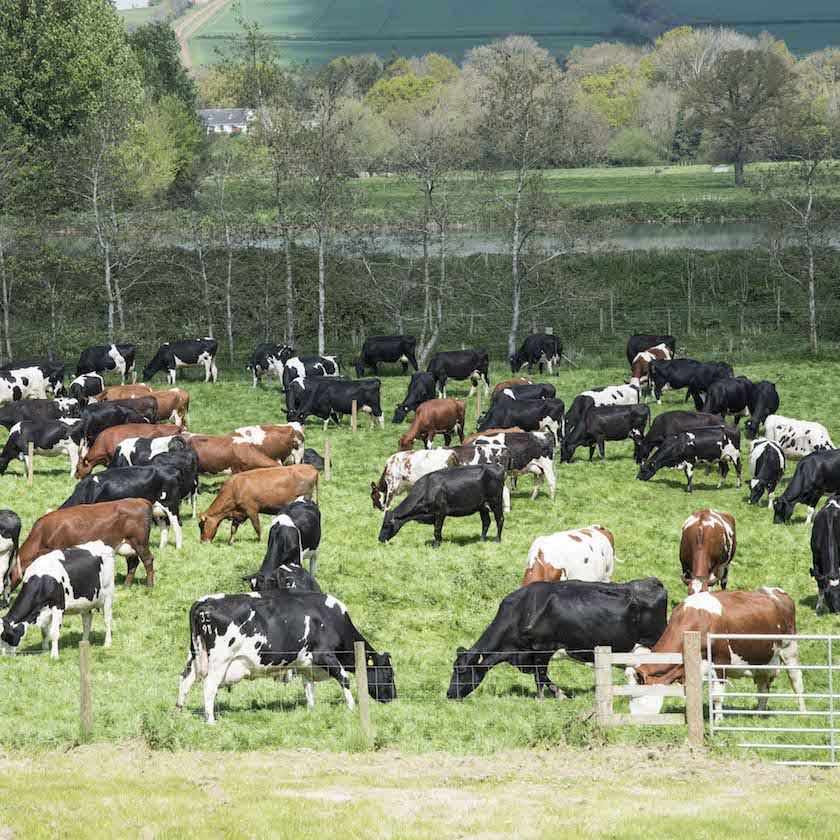 We had been asked to arrive as early as possible (I was travelling with my other half), because the whole cheese-making process kicks-off early. Not an unreasonable request, except we were spending the night before on the west coast of Cornwall. Fortunately for us the next morning was perfect for driving, and thanks to Google Maps, after negotiating a maze of narrow lanes and hedgerows, we finally arrived at Quicke’s just before 10.00 – early, at least by our standards.
We had been asked to arrive as early as possible (I was travelling with my other half), because the whole cheese-making process kicks-off early. Not an unreasonable request, except we were spending the night before on the west coast of Cornwall. Fortunately for us the next morning was perfect for driving, and thanks to Google Maps, after negotiating a maze of narrow lanes and hedgerows, we finally arrived at Quicke’s just before 10.00 – early, at least by our standards.
At Home Farm we were welcomed by our guide for the day, Tom Chatfield, a very friendly young man with an encyclopaedic knowledge of the history and workings of the dairy. Tom gave us a brief overview before taking us on our tour. We were about to discover the fine art of traditional cheddar-cheese making.
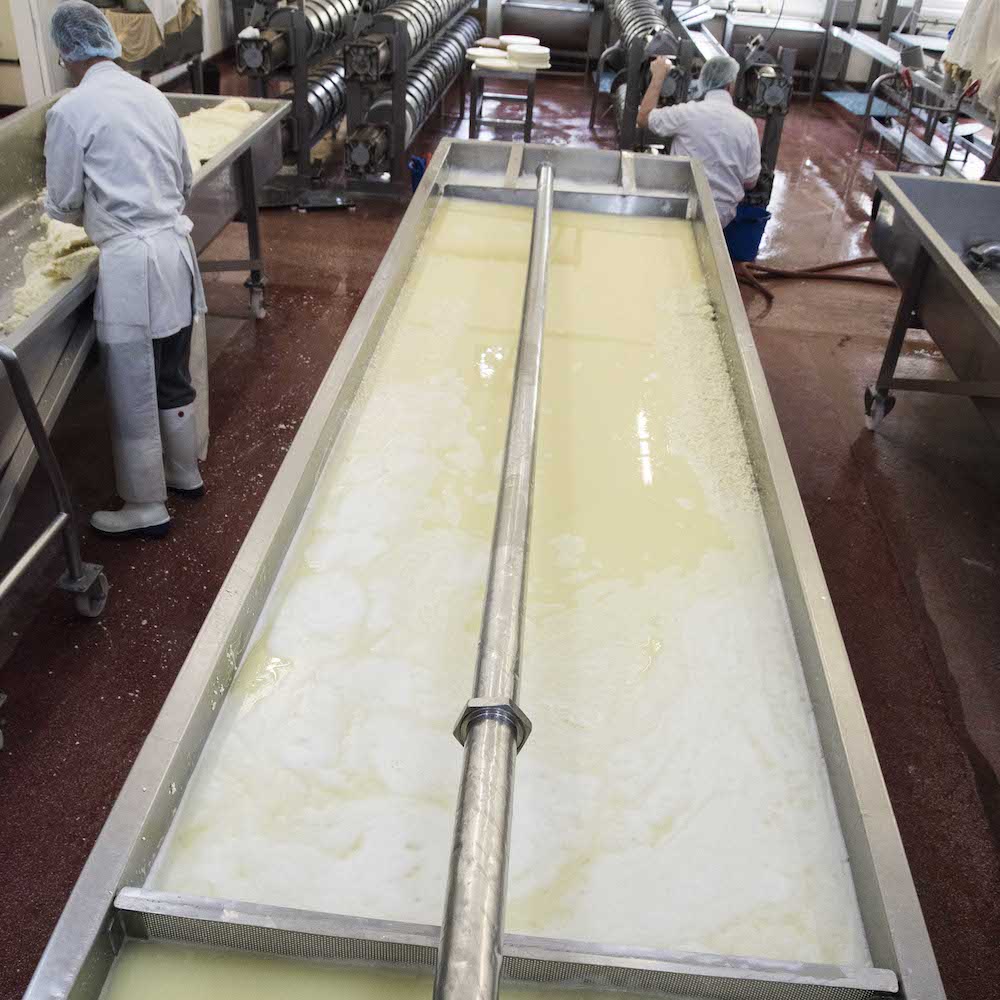 Our first stop a building where the cheese making takes place – our first lesson: health and safety. You can’t enter this area without first donning Wellies, smock and hairnet (never a good look), and thoroughly washing your hands. Appropriately suited-up, we enter a large hanger-like room filled with polished-steel tanks and pipes, and plastic hoses. The shallow rectangular tanks are filled with great slabs of creamy curd and the room is humid and smells of warm milk, but strangely, not unpleasant. To my surprise, I discovered there are only a handful of cheddar makers in Britain using traditional methods – Quicke’s being one. And it’s all about the cultures.
Our first stop a building where the cheese making takes place – our first lesson: health and safety. You can’t enter this area without first donning Wellies, smock and hairnet (never a good look), and thoroughly washing your hands. Appropriately suited-up, we enter a large hanger-like room filled with polished-steel tanks and pipes, and plastic hoses. The shallow rectangular tanks are filled with great slabs of creamy curd and the room is humid and smells of warm milk, but strangely, not unpleasant. To my surprise, I discovered there are only a handful of cheddar makers in Britain using traditional methods – Quicke’s being one. And it’s all about the cultures.
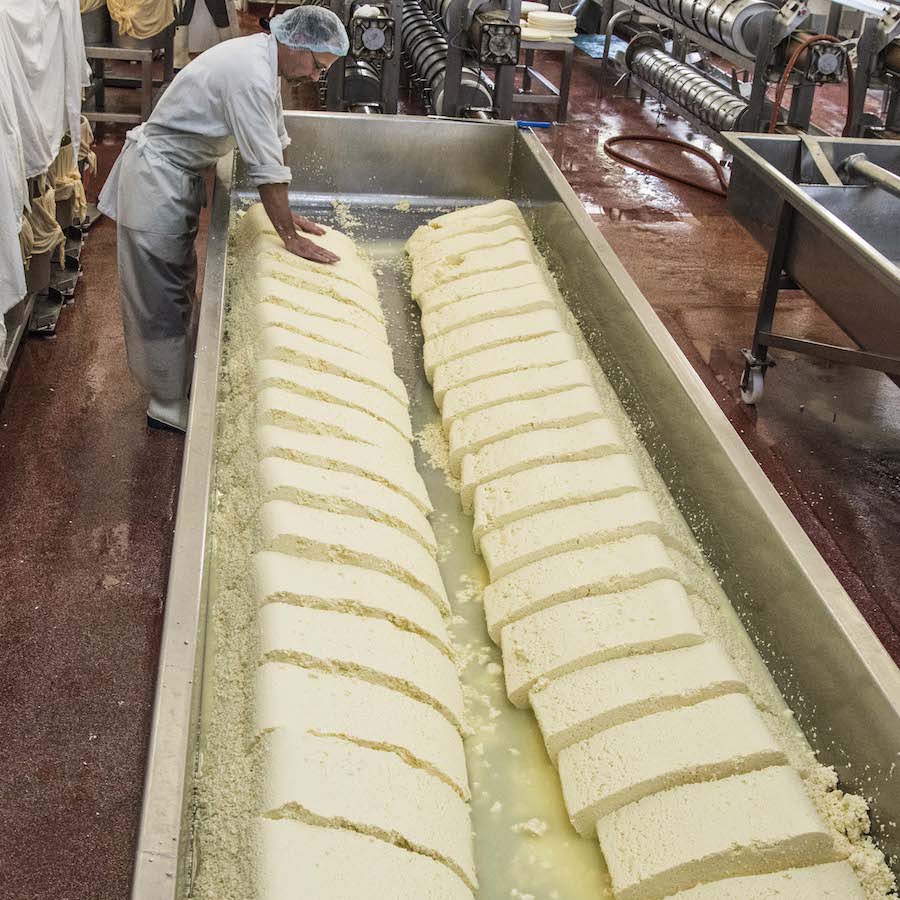 The cultures are derived from wild fermentation, like one would cultivate in a sourdough, natural wine or craft beer. A gentleman named John Lewis had the foresight to visit the best cheddar dairies in the South West of England in the 1960s and 70s to collect the finest samples of these wild fermentations and keep them as mother cultures.
The cultures are derived from wild fermentation, like one would cultivate in a sourdough, natural wine or craft beer. A gentleman named John Lewis had the foresight to visit the best cheddar dairies in the South West of England in the 1960s and 70s to collect the finest samples of these wild fermentations and keep them as mother cultures.
Today in Britain, only these few cheesemakers use the heritage starters, which Mary Quicke describes as the “mothership” cheddar cultures. Quicke’s, Montgomery’s and Barbers are probably the best known.
These are the starters use today. They are rotated (so they don’t succumb to viral attacks on the strains) meaning each day’s cheese is made using a different collection of microflora. The starters come in a frozen pint (curated by the Barber family, also known for their block cheddar of the same name). They then inoculate a churn of milk with that pint, the day before the cheese is made, so it can reawaken and flourish.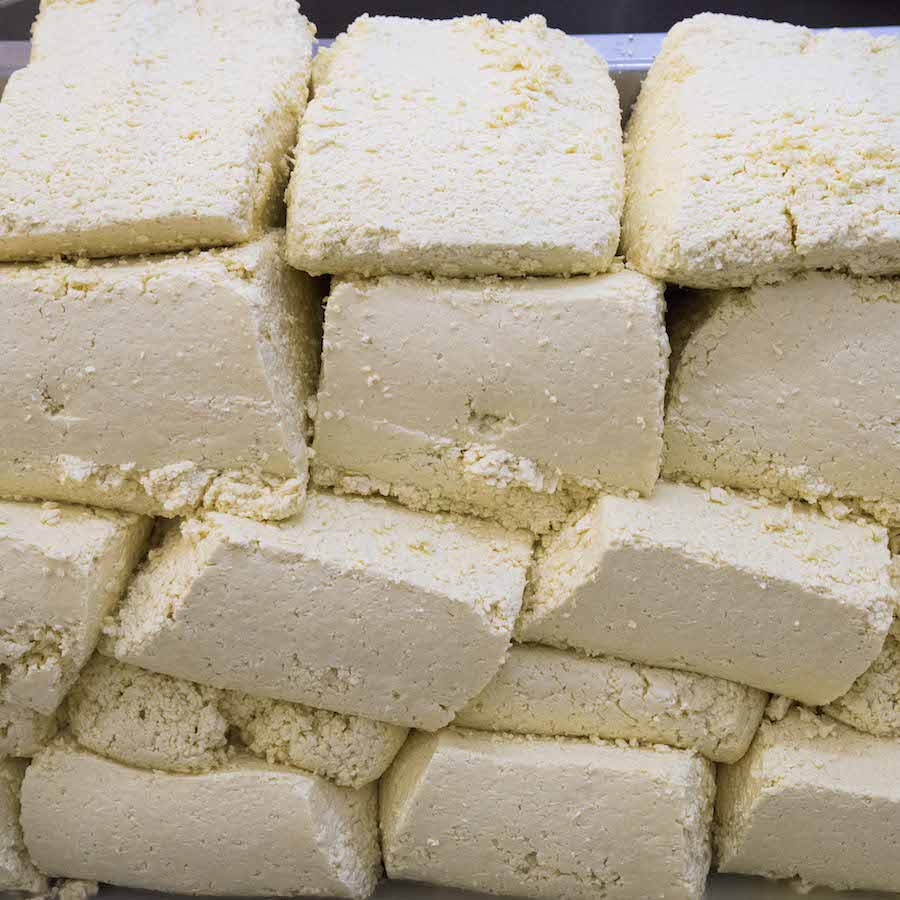
We learned all this while watching the traditional cheddaring process where the curd is cut into blocks and turned by hand to drive out the moisture. The cheesemakers bending over their work reminded me of peasant-women washing clothes in a river. Every cheese is hand crafted by one of the cheesemakers. After cheddaring the cheese is milled, a little salt added, and then it’s hand-kneaded into moulds to make its distinctive shape. Finally each cheese is clothbound (wrapped in muslin) to allow it to breathe while maturing.
Tom introduced us to Malcolm, who heads up the dairy. He’s been on the farm for 35 years. His motto is “do what we know to do” when making cheese; meaning trust the intuition and discipline that over three decades of practice has imparted on his craft. The cheese over Mal’s tenure has gone from strength to strength and Quicke’s global reputation is owed in no small part to his commitment to getting it right. Mal has also brought three cheesemakers through the ranks including his son.
As an aside, we were taken into a smaller room where a very clever young lady with wooden-paddles was hand-rolling individual cylinders of butter: she can roll a couple-of-hundred a day perfectly. She wanted to know if I’d like to have a go; I should have said no. It took me four times as long and wasn’t remotely cylindrical. And although my husband thought my attempts entertaining rather than accurate, she was at least complimentary.

 Next we visited the nursery. Here the mould garden grows on the rind of each cheese creating the rich, horseradishy flavour I love so much. For the next three months each cheese is lovingly turned by hand to keep them in balance as they dry out. They enter the nursery weighing 27 kilos and leave weighing 25.
Next we visited the nursery. Here the mould garden grows on the rind of each cheese creating the rich, horseradishy flavour I love so much. For the next three months each cheese is lovingly turned by hand to keep them in balance as they dry out. They enter the nursery weighing 27 kilos and leave weighing 25.
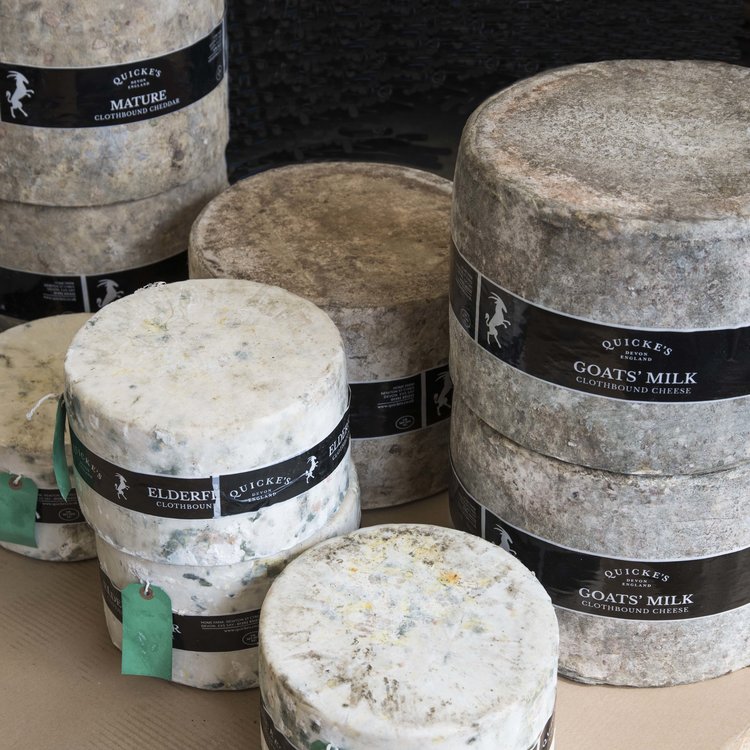 But this is still early days in the process; following this, for next eighteen-months to two years, depending on the style, these truckles get to age in my new favourite room – the Quicke’s people call it the ‘Cheese Cathedral’ and I can see why – it’s as near to heaven-on-earth as a cheese lover can get. It’s massive and tall and cool and dark, and smells of horseradish and history. There are about 9,000 truckles aging and being regularly turned on steel racks that almost touch the ceiling. Depending on style and maturity a truckle will sell for 200 to 400 pound. You can do the math.
But this is still early days in the process; following this, for next eighteen-months to two years, depending on the style, these truckles get to age in my new favourite room – the Quicke’s people call it the ‘Cheese Cathedral’ and I can see why – it’s as near to heaven-on-earth as a cheese lover can get. It’s massive and tall and cool and dark, and smells of horseradish and history. There are about 9,000 truckles aging and being regularly turned on steel racks that almost touch the ceiling. Depending on style and maturity a truckle will sell for 200 to 400 pound. You can do the math.
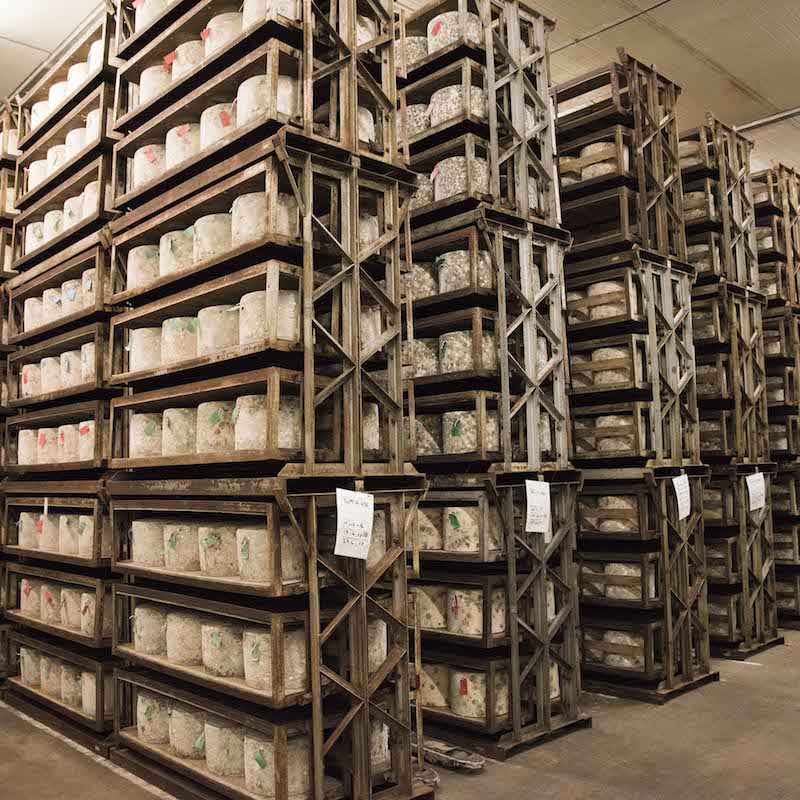 From the ‘Cathedral’ we visited the cows; a herd of about 300 standing in a fenced pasture chewing their cuds. This is where it all begins, these happy bovines a mix of Kiwi Holstein, Scandinavian Red, Montbeliarde, Kiwi Friesian and Jersey. Tom says this hybrid breed gives the perfect milk for cheese making. Who am I to argue? And they look so cuddly. They stock on pasture one cow per acre, with ‘their girls’, as they call them, on the grass for usually 10-11 months (weather permitting). They then grow a little arable, mostly cereal grasses and also corn/maize for whole cropping into their silage (pickled grass) for bulking out the feed for the winter months.
From the ‘Cathedral’ we visited the cows; a herd of about 300 standing in a fenced pasture chewing their cuds. This is where it all begins, these happy bovines a mix of Kiwi Holstein, Scandinavian Red, Montbeliarde, Kiwi Friesian and Jersey. Tom says this hybrid breed gives the perfect milk for cheese making. Who am I to argue? And they look so cuddly. They stock on pasture one cow per acre, with ‘their girls’, as they call them, on the grass for usually 10-11 months (weather permitting). They then grow a little arable, mostly cereal grasses and also corn/maize for whole cropping into their silage (pickled grass) for bulking out the feed for the winter months.
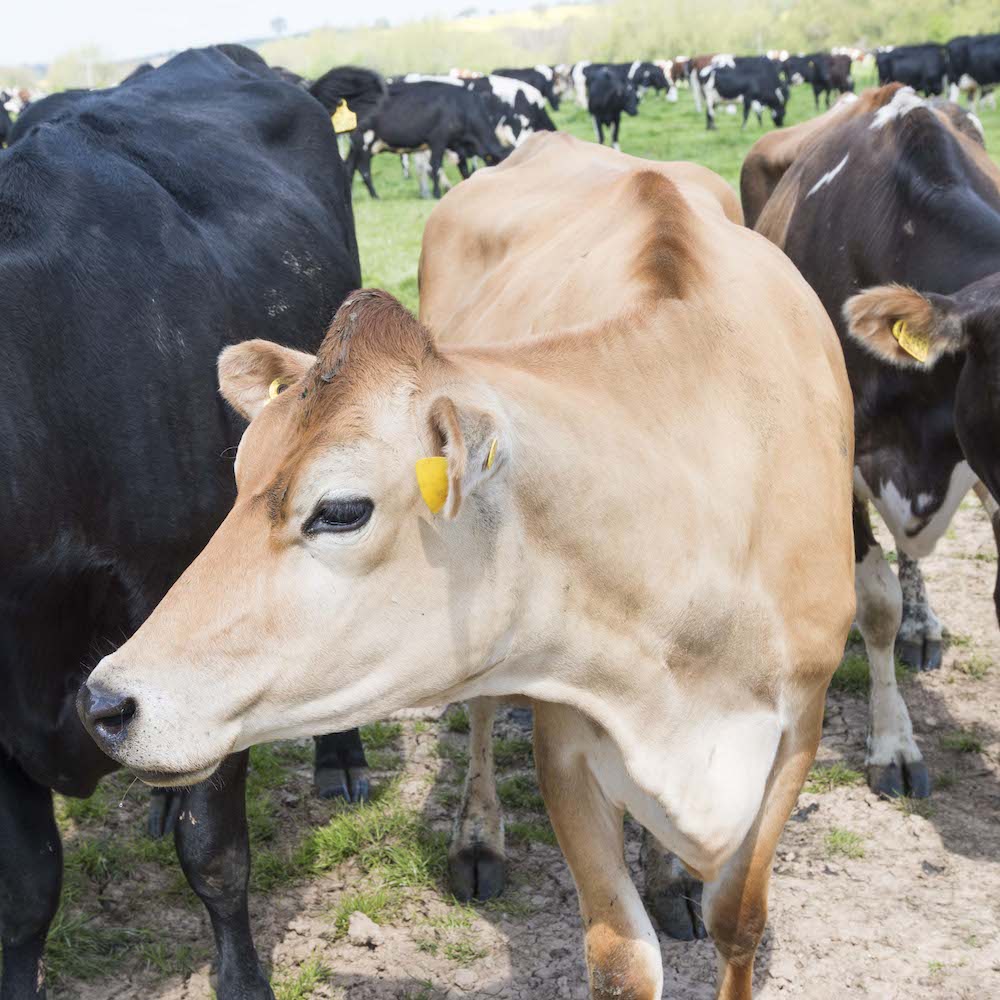 We discovered Quicke’s was about to begin using salt supplied by the Cornwall Sea Salt Company (a first for UK cheddar makers and the purest salt available), and although more expensive than your run-of-the-mill salt, they believe will add complexity and another dimension in flavour to their cheddar. This new cheddar will be landing in Australia in October.
We discovered Quicke’s was about to begin using salt supplied by the Cornwall Sea Salt Company (a first for UK cheddar makers and the purest salt available), and although more expensive than your run-of-the-mill salt, they believe will add complexity and another dimension in flavour to their cheddar. This new cheddar will be landing in Australia in October.
We finished up our visit in the Farm Shop and Kitchen. Lunch with lots of, you guessed it, cheddar – just not one I’d ever tasted before – absolutely delicious. In fact we bought wedges of all the cheddars we can’t get in Australia to try later. They make 8 different cheddars altogether, along with 2 goat milks, a ewes’ milk, a whey butter, and because of the quality of the cream a fabulous ice-cream.
I walked away with a new respect for my favourite cheddar and the people who craft it.
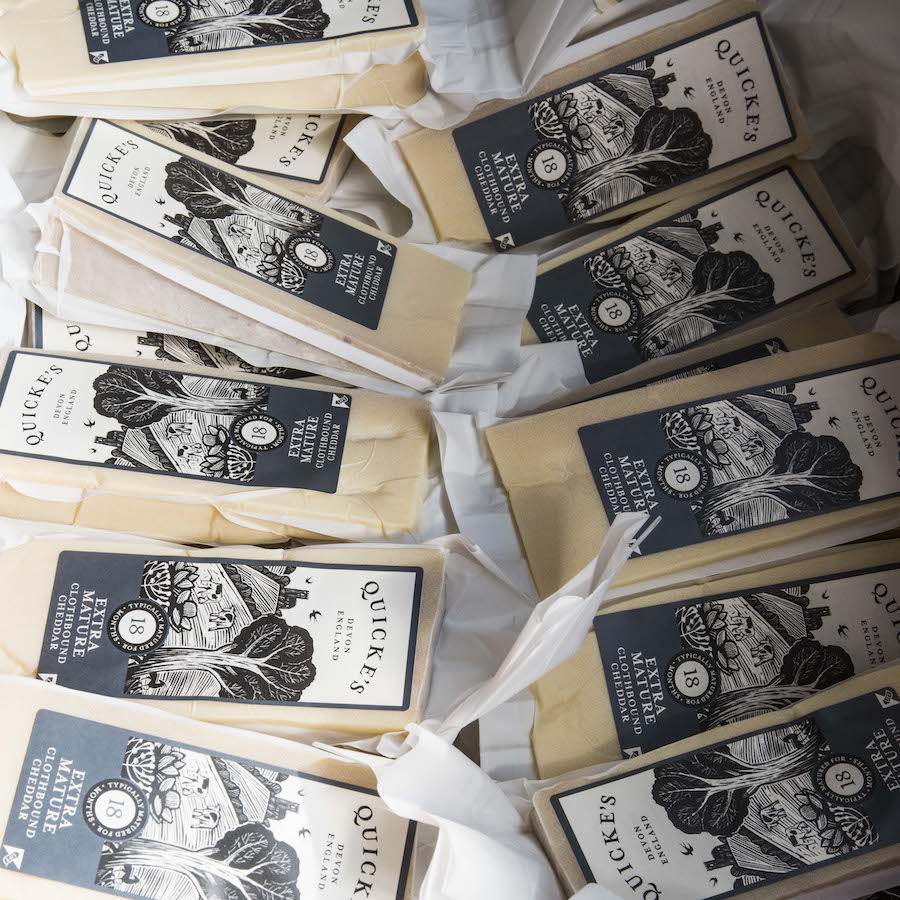 *For those who aren’t aware, cheddar takes its name from the village of Cheddar in Somerset, yet curiously enough, unlike Champagne, doesn’t have exclusivity to the name. Even Australia has local cheeses labelled cheddar; that not only don’t come from the region, but also aren’t made in the traditional way. It’s not that some of the local product isn’t good; I’m just not sure what it has to do with real cheddar.
*For those who aren’t aware, cheddar takes its name from the village of Cheddar in Somerset, yet curiously enough, unlike Champagne, doesn’t have exclusivity to the name. Even Australia has local cheeses labelled cheddar; that not only don’t come from the region, but also aren’t made in the traditional way. It’s not that some of the local product isn’t good; I’m just not sure what it has to do with real cheddar.
Here is a clarification I found on Wikipedia:
‘The term “cheddar cheese” is widely used, but has no Protected Designation of Origin within the European Union. However, in 2007, a Protected Designation of Origin, “West Country Farmhouse Cheddar”, was created and only Cheddar produced from local milk within Somerset, Dorset, Devon and Cornwall and manufactured using traditional methods may use the name.’ 
Quicke’s Tomato Galette with Cheddar Pastry
Serve the galette warm to appreciate the full flavours of the cheese pastry, summer tomatoes, and the extra zing of the Ewes’ Milk cheese.
The galette serves 4 people, but it’s very easy to double the recipe if you choose. As well as the ingredients listed below, you will also need, about 50g grated Quicke’s Ewes’ Milk Clothbound Cheese, fresh sprigs of rosemary and tarragon, and extra virgin olive oil.
Roasted Tomato Sauce
This recipe makes more than you will need for the galette. Freeze the rest, it’s wonderful as a topping for pizzas too, or to make into a soup by adding chicken or vegetable stock
1kilo ripe tomatoes, thickly sliced
1 brown onion, peeled and sliced
1 large, or 2 small bulbs fennel, sliced
8 cloves garlic, skin on
1/2tsp coriander seeds
1/2tsp fennel seeds
Rosemary, thyme and marjoram sprigs
Sea salt flakes and freshly ground black pepper
Extra virgin olive oil
Preheat oven to 180C and line a baking tray with baking paper. In a small fry pan toast the coriander and fennel seeds over a low heat until fragrant. Be careful not to let them burn. Remove to a mortar and pestle and crush, but not to a powder. Set aside. Lay the onion slices on the baking paper, followed by the fennel, and tuck the garlic and some of the herb sprigs in and around the vegetables. Lay the tomato slices on top, season with salt, pepper the crushed coriander and fennel seeds, and scatter with leaves from the rest of the herb sprigs. Drizzle generously with olive oil and place in the preheated oven for ½ hour. Then turn the oven down to 160C, and roast for another hour until caramelized and soft. Remove from oven, discard any twiggy herb branches, and slip the roasted garlic from its skin. Put everything in a food processor and blitz until it becomes a thick purée. Remove, and drain in a muslin-lined sieve over a bowl for 2 hours. This will rid the sauce of any excess liquid. Put in the fridge until needed. It will keep for up to 5 days, or 3 months in the freezer.
Roasted Tomatoes
10 medium size ripe truss tomatoes
3 cloves smoked garlic, peeled and cut into slivers
2tbsp small sprigs of rosemary
Sea salt and freshly ground black pepper
Extra virgin olive oil
Preheat oven to 180C and line a baking tray with baking paper. Cut the top quarter off the tomatoes and discard, place tomatoes on tray. Push garlic slivers and rosemary sprigs into the tops of tomatoes, sprinkle with salt and pepper, and drizzle with olive oil. Place in the oven for 30 minutes, then turn oven down to 150C and roast for another 45- 60 minutes. At this stage, they should have dried out somewhat, and be ready. Turn off the oven and let them sit inside until cool. Do not refrigerate.
Quicke’s Cheddar Pastry
270g plain flour, plus a bit extra for dusting
60g grated Quicke’s Cheddar
1 tsp sea salt
170g cold unsalted butter, cut into small pieces
1 large egg yolk
¼ cup ice water
1 large egg yolk, and 1tbsp milk for egg wash
Pulse flour, cheese, salt and butter in a food processor until the mixture resembles coarse breadcrumbs. Add egg yolk, and pulse to combine. Drizzle in ¼ cup water slowly, and pulse until the dough just comes together. Do not overwork, or dough will become tough when baked. Remove dough from food processor, form into a disc, wrap and refrigerate for 30 minutes.
When ready to bake, preheat oven to 200C, remove pastry from fridge, unwrap, and roll out to a diameter of approximately 30cm between 2 sheets of baking paper. Put a thin layer of the roasted tomato sauce in the middle, leaving a 5cm border around the perimeter (You will have sauce leftover). Place roasted tomatoes over the sauce and bring the sides of the pastry up to just cover some of the tomatoes. Drape loosely, it doesn’t need to be perfect. Make an egg wash with the egg yolk and milk, and with a pastry brush gently brush the exposed pastry with the glaze. Place the tart, still on baking paper onto a baking sheet, and put it in the oven. Bake for 15 minutes, turn oven down to 180C and bake for another 15 minutes. The tart will be golden brown, and the pastry will be crisp. Remove from oven, scatter with the grated Quicke’s Ewes’ Milk Cheese and fresh herbs, drizzle with olive oil, and serve warm.



